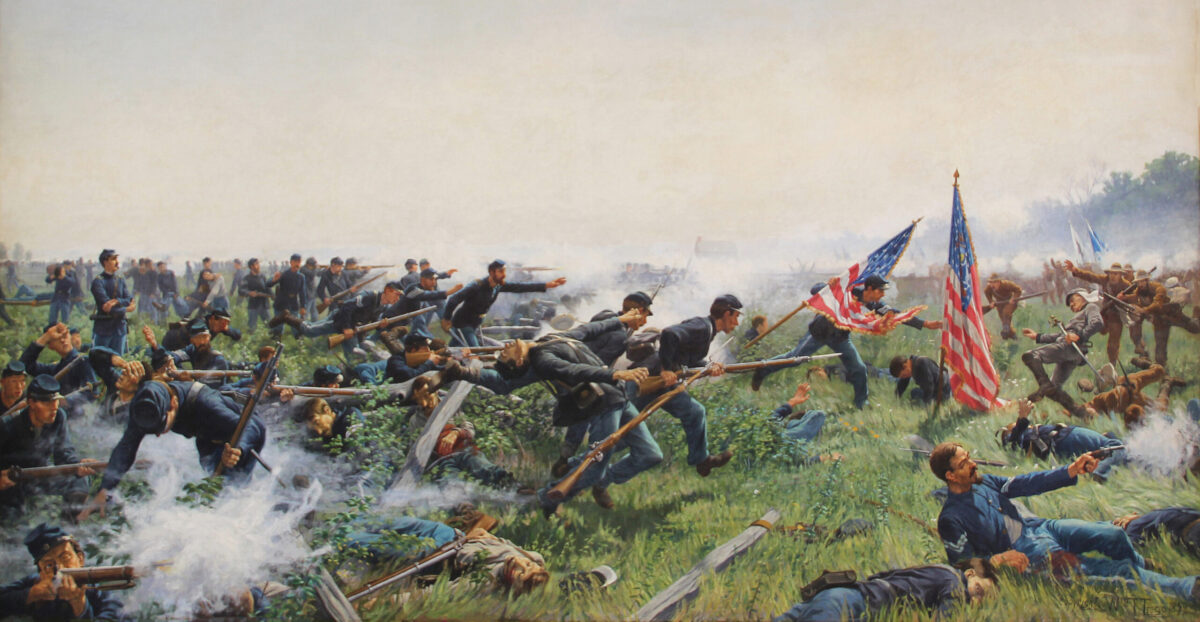“No action of the civil war has been so little understood as that of Seven Pines,” Confederate General Joseph E. Johnston would write in his 1874 memoir, Narrative of Military Operations. Ironic, as Johnston’s own actions during and after the critical Peninsula Campaign battle on May 31–June 1, 1862, are certainly a reason why this is so.
Captain George W. Mindil of the 61st Pennsylvania Infantry, a staff officer in the Union Army of the Potomac that faced Johnston’s Army of Northern Virginia during the battle, later observed that the enemy commander’s “plan was faultless….[H]ad this plan been fully executed…the left wing of McClellan’s army would have sustained irreparable disaster and the retreat of the whole [Union] army would have followed.”
Instead, the outcome of the two-day clash that resulted in more than 11,000 casualties (typically known to Northerners as Fair Oaks) was inconclusive. In addition, controversy and acrimony arose when both Johnston and one of his top subordinates, Maj. Gen. James Longstreet, audaciously asserted that despite a simple “misunderstanding” between the two, victory still would have been possible had it not been for the “incompetence” of Maj. Gen. Benjamin Huger, a division commander in Longstreet’s Right Wing.
The word “misunderstanding” generally implies the commission of an honest mistake or perhaps a communication failure—usually indicating no ill-intent by the participants. The purported miscue at Seven Pines, however, was a well-crafted fabrication designed both to shield Longstreet’s poor decision-making and insubordinate conduct during the battle and to deflect attention away from Johnston’s own leadership failures.
As Colonel Charles Marshall, Confederate General Robert E. Lee’s aide-de-camp, would caustically point out, Johnston had the knack of compensating for his deficiencies through his use of the “certain ‘agility’ of explanation.” Regarding Johnston’s post–Seven Pines account, Marshall wrote that “a lie well adhered to & often repeated, will sometimes serve a man’s purpose as well as the truth & better.”
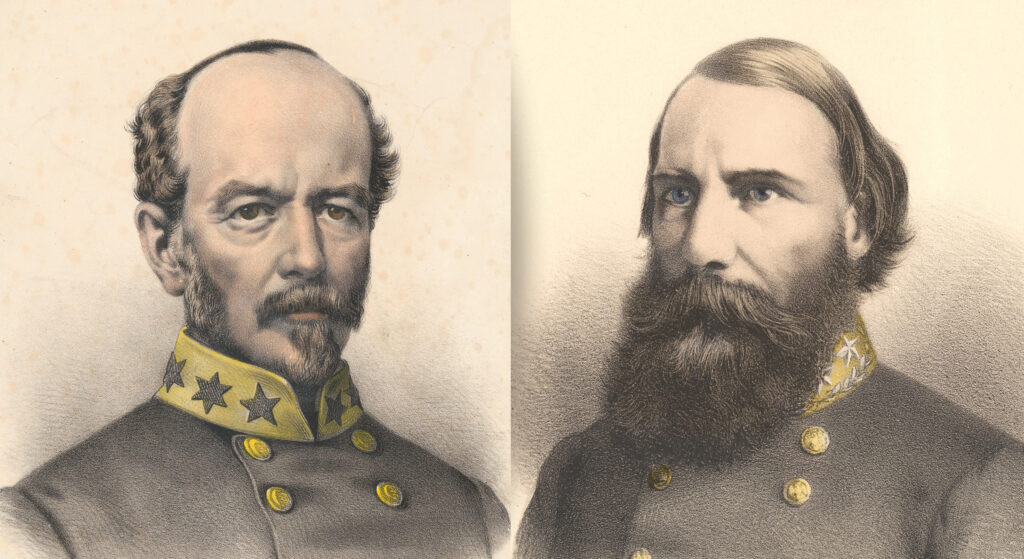
By late May 1862, Johnston’s relationship with Confederate President Jefferson Davis was so strained, had he acknowledged the truth about the battle, it would have tarnished both his and Longstreet’s reputations. That left the unfortunate Huger as the target of an unconscionable attack.
“Misunderstanding” first appeared in Johnston’s June 28, 1862, letter to Maj. Gen. Gustavus W. Smith, his Left Wing commander, in response to Smith’s after-action report. “My Dear Gustavus,” Johnston wrote, “I inclose herewith the first three sheets of your report, to ask a modification, or omission rather. They contain two subjects which I intended never to make generally known. I refer to the misunderstanding [italics added by author] between Longstreet and myself in regard to the direction of his division.”
The relationship between Johnston and Smith had once been close. In August 1861, in fact, Johnston wrote to Davis that “Smith is an officer of high ability, fit to command in chief.” And the following February, Johnston informed Davis: “I regard Maj. Gen. G.W. Smith as absolutely necessary to this army.”
Johnston’s warm tone now belied their recent strain. In addition to sustaining the alleged misunderstanding, Johnston justified his request to omit portions of Smith’s report as “these matters concern Longstreet and myself alone. I have no hesitation in asking you to strike them from your report as they in no manner concern your operations.”
Although Smith complied with Johnston’s request “because of [his] great personal attachment” to his commander, he maintained a copy of his original and entered a note stating that Johnston “is mistaken in supposing that the misunderstanding between himself and General Longstreet did not affect the operations of my division.”
The suppression of Smith’s report would become the cornerstone of the burgeoning “misunderstanding” myth. Smith, however, wisely saved copies of all his communications. In 1884, he published his original report including those previously omitted references.
Plan of Attack
Seven Pines/Fair Oaks would be a definitive battle in Maj. Gen. George McClellan’s ill-fated Peninsula Campaign. On May 20, “Little Mac” had begun moving part of his army across the Chickahominy River, closing to within 10 miles of Richmond. The 12,500-man 4th Corps, under Brig. Gen. Erasmus Keyes, crossed the river near Bottom’s Bridge, followed by Brig. Gen. Samuel P. Heintzelman’s 3rd Corps. Keyes would move his corps to Seven Pines; Heintzelman’s corps, with 15,000 men, remained near the Chickahominy—the two units largely deployed along the Williamsburg Road. Although White Oak Swamp provided protection to their left, their right flank was vulnerable, lacking a natural barrier.
Seven Pines lay approximately six miles east of Richmond at the intersection of the Williamsburg and Nine Mile roads. Approximately one mile north of Seven Pines, along Nine Mile Road and the Richmond & York River Railroad, sat a small depot called Fair Oaks Station. To protect his right flank, Keyes positioned a brigade at the depot.
The Confederate lines began at a point two miles north of the station along Nine Mile Road near an area known as Old Tavern. There were approximately 87,800 men in Johnston’s army, extending in an arc along the Chickahominy to the north down to Drewry’s Bluff.
Johnston fully recognized the vulnerability of the Federal position south of the Chickahominy; however, he also had learned that Brig. Gen. Irwin McDowell’s 1st Corps had left Fredericksburg, heading toward McClellan’s main lines. A strike on McClellan above the Chickahominy was essential before that could happen.
During a council of war on May 28, Johnston proposed an attack on the Union position at Mechanicsville, which would prevent McDowell from linking with Brig. Gen. Fitz John Porter’s 5th Corps. When they learned McDowell’s corps had begun returning to Fredericksburg, Smith advocated calling off the attack. Johnston at first agreed, which infuriated Longstreet, still convinced a turning movement against the Federal position would yield certain victory. Johnston was swayed by his subordinate’s passion.
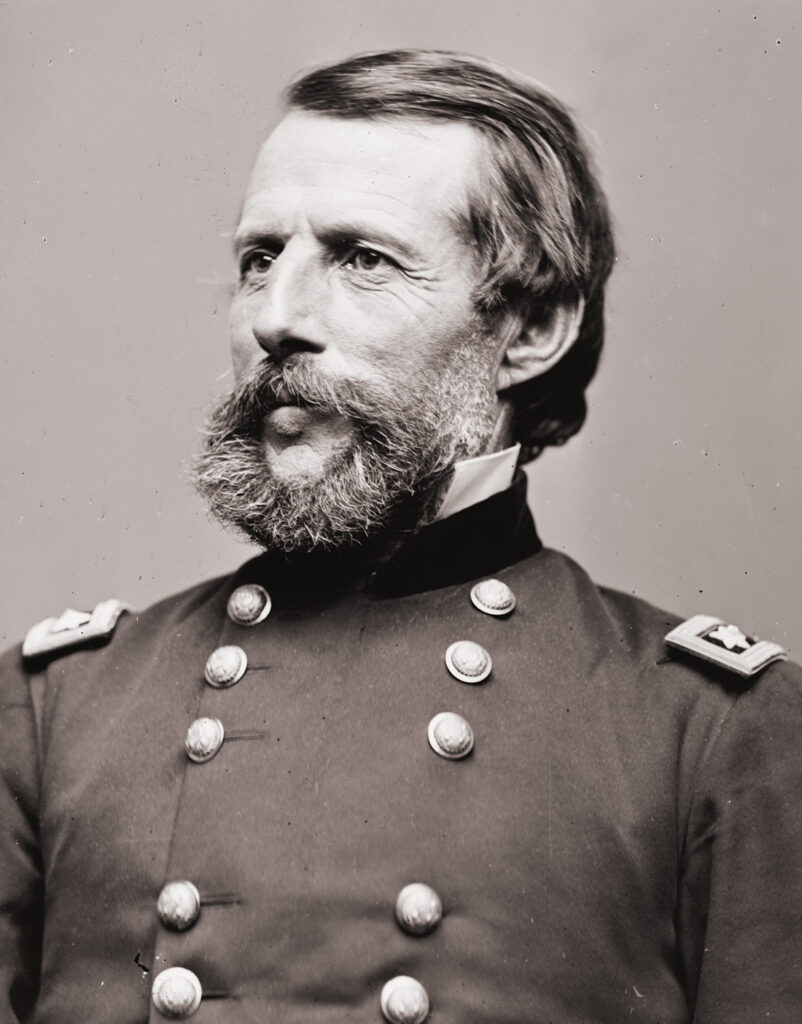
On May 30, Maj. Gen. D.H. Hill in Longstreet’s Right Wing reported that Keyes’ corps was arrayed in force along the Williamsburg Road but was vulnerable from the Charles City Road. Johnston promptly ordered an attack to take place the following day.
Without Smith in attendance, Johnston met with Longstreet the afternoon of May 30. After designating Longstreet as the commander of the assaulting force, consisting of three divisions, the generals weighed their options on how to best conduct the attack. They determined that at 8 a.m. Hill’s command would open the attack along the Williamsburg Road, striking the 4th Corps on its front.
Hill’s advance, however, required the inclusion of the 2,200-man brigade commanded by Brig. Gen. Robert Rodes, presently posted along the Charles City Road. To address that need, Johnston ordered Huger, in Longstreet’s Wing, to march his 6,250-man division over from Drewry’s Bluff to relieve Rodes’ Brigade prior to the assault. Huger would then occupy a position opposite the 4th Corps’ left flank.
Longstreet would then move his 13,800-man division, commanded here by Maj. Gen. Richard H. Anderson, east along the Nine Mile Road to Old Tavern, putting it squarely on Keyes’ right flank.
One concern the generals had with this plan was how to bolster the overall strength of Hill’s attacking force. Johnston could move Longstreet’s Division (under Anderson) to support Hill, but complicated logistical factors ruled out that option. Not only would Anderson’s men have to move during the night, it would also necessitate coordination with Huger’s command, as each division would be required to occupy the same stretch of the Williamsburg Road, even if only temporarily.
Another option in supporting Hill was to reposition Gustavas Smith’s six-brigade division (with Brig. Gen. William H.C. Whiting in command). This appeared as the most logical choice, but it also posed an unavoidable complication. Because Smith outranked Longstreet, the movement would place Smith in command of the attack and not “Old Pete.” As Johnston had designated Longstreet as the overall commander of offensive operations, he decided against that option, choosing instead to advance Smith’s Division closer to Old Tavern in support of Longstreet. After considering his options, and with an intense rainstorm now unloading on the area, Johnston determined that rather than move Longstreet or any additional force to the Williamsburg Road, the attack would proceed as followed:
1) Before dawn, General Huger would proceed to the Charles City Road and relieve Rodes’ Brigade, enabling Rodes to join Hill.
2) With Rodes’ arrival, Hill would launch the attack along the Williamsburg Road.
3) Doing so would be the signal for Longstreet’s flank attack down the Nine Mile Road.
4) Smith’s Division would remain in reserve along the Nine Mile Road in support of Longstreet.
“There was…no reason why the orders for march should be misconstrued or misapplied,” Longstreet later wrote. “I was with General Johnston all of the time that he was engaged in planning and ordering the battle, heard every word and thought expressed by him of it, and received his verbal orders; Generals Huger and Smith received his written orders.”
Interestingly, Longstreet never identified or described in his report or postwar writing the specific orders he had received. Nor did Longstreet reveal his division’s own marching orders—although he did provide details of those he had issued Huger, Smith, and McLaws. Furthermore, Longstreet never divulged the subsequent orders he issued to his division, or to Hill.
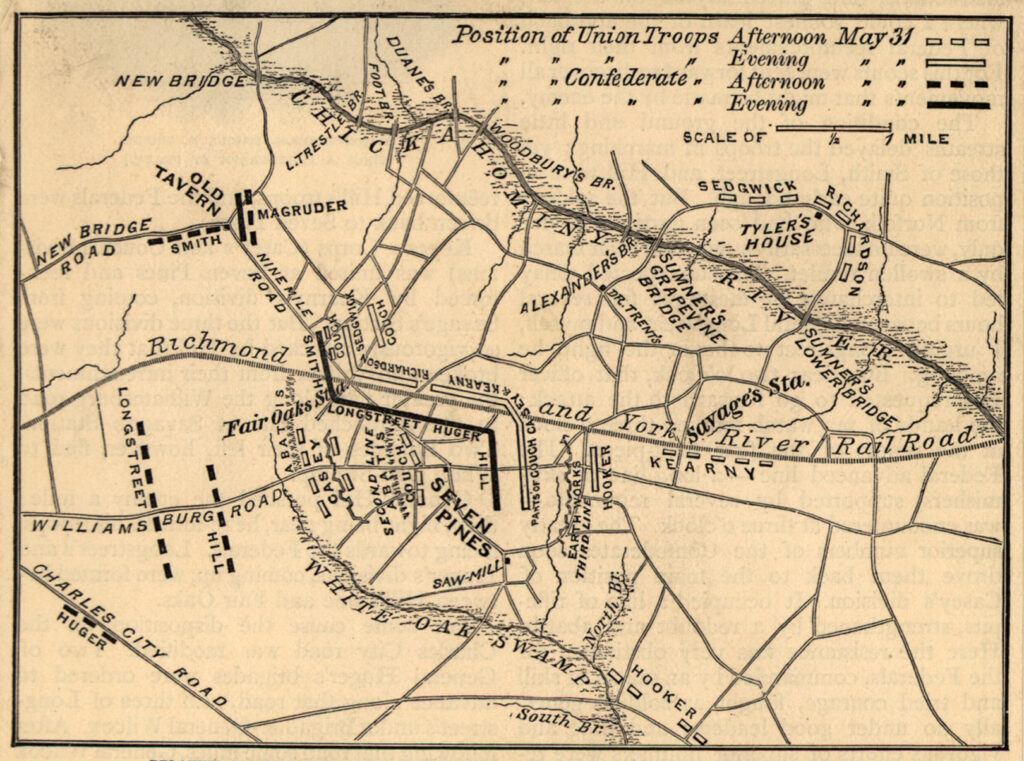
What, therefore, went wrong? Simply put, Longstreet went rogue. Regardless of his full knowledge of Johnston’s intentions, he willingly altered the attack plans. No “honest mistake” or “failure to understand directions correctly” was involved:
1) Longstreet not only disregarded Johnston’s original order, he never communicated to his commander his movements, location, status, or progress once the attack began.
2) He somehow also ignored the weather, which he fully knew was dreadful, later writing, “While yet affairs were under consideration [on May 30], a terrific storm of vivid lightning, thunderbolts, and rain, as severe as ever known to any climate, burst upon us, and continued through the night more or less severe. In the first lull I rode from General Johnston’s to my head-quarters, and sent orders for [an] early march.”
3) He ignored the importance of Huger’s orders to relieve Rodes on the Charles City Road.
Because Johnston and Longstreet conferred for some time, it is hard to believe Longstreet was not informed which road he was to use. Longstreet, of course, had long been hoping for an independent command. Choosing to follow the Williamsburg Road was clearly an opportunity for him to flout his orders for an attack plan of his own discretion.
All six of Longstreet’s brigades were positioned near the Nine Mile Road, which required only a short march east to reach Old Tavern. Had Longstreet’s brigades moved out at 3:30 a.m., they would have reached Old Tavern by 6 a.m.
“The tactical handling of the battle on the Williamsburg Road was left to my care, as well as the general conduct of affairs south of the York River Railroad,” Longstreet later wrote, but he never offered to explain why he altered Johnston’s plan or even why he did not communicate with his commander until late in the afternoon—undeniably insubordinate conduct.
As for the weather’s impact, Longstreet had held field commands from First Manassas through the Peninsula Campaign. His experience was extensive enough to realize a “terrific” and “severe” rainstorm would severely hamper the nighttime movement of a 13,800-man division. Had Longstreet followed orders and marched east along the Nine Mile Road, crossing the flooded Gillies Creek would not have been the roadblock it was.
A Disputed Crossing
The movement of Huger’s Division was the key to a successful attack. In relieving Rodes along the Charles City Road, Rodes could join Hill as ordered and the attack on Keyes’ position launched. But when the lead elements of Longstreet’s Division descended the steep bluffs toward Gillies Creek, they found it “bank full” and unfordable. To cross the swollen creek, Longstreet’s men placed a wagon in the stream as a trestle and laid planks to both banks, allowing a single-file crossing.
As that began, however, Huger appeared. Despite knowing what was at stake, Longstreet responded that “[a]s we were earlier at the creek, it gave us precedence over Huger’s division…” Hill’s attack would have to wait.
It is also mystifying that Longstreet later insisted he believed Huger had already crossed Gillies Creek. No doubt a division the size of Huger’s certainly would have left evidence of such a crossing.
Finding Longstreet already occupying the creek was just one of a day full of surprises for Huger, who also revealed it was “the first I knew” of a planned May 31 attack. Even if one accepts Longstreet’s “misunderstanding” of his orders, it doesn’t justify his rationale in preventing Huger’s Division from advancing to its assigned Charles City Road position.
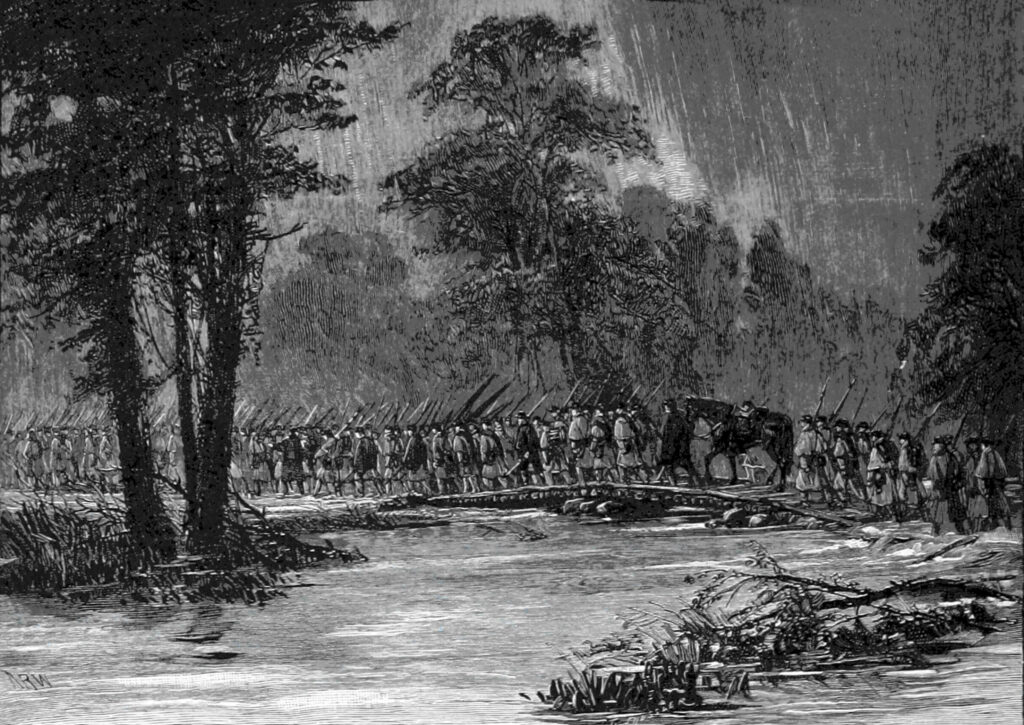
Johnston’s responsibility for the attack’s implosion cannot be ignored either. After all, Huger received only two communications from him: one at 8:40 p.m. May 30; the other May 31, with no time indicated. Johnston was directing Huger to relieve Rodes, and that “if you find no strong body in your front, it will be well to aid General Hill.”
Huger interpreted that to mean he was moving to a new position and not into battle, as the only general named in either note was Hill. Neither mentioned Longstreet being in command of the wing, Hill’s expected attack, nor Huger’s role in that attack. He also described the communications from Johnston as being an “autograph note and not an official order.”
The lack of clarity regarding Huger’s expected role in the upcoming battle is borne out in his statement, “If I would have been notified that Longstreet was to pass, I would have made another crossing.” When he met with Longstreet at Hill’s headquarters, Huger also fully realized: “He was moving to attack the enemy.”
Longstreet Crafts a Narrative
The only general who deserves absolution for the opening attack’s delay is Huger. By June 7, Longstreet had already put the “misunderstanding” myth and the character assassination of Huger in his letter to Johnston. The letter began friendly enough, with Longstreet expressing syrupy concern for the seriously wounded commander before segueing into claims that, despite his division’s heroics, he had been victimized by Huger’s lethargy:
“The failure of complete success [May 31] I attribute to the slow movements of General Huger’s command….I can’t but help think that the display of his forces on the left flank of the enemy…would have completed the affair.”
Longstreet asserted deceitfully that Huger’s ineffectiveness “threw perhaps the hardest part of the battle upon my own poor division. It is greatly cut up….Our ammunition was nearly exhausted when [General] Whiting moved.” “Altogether,” he concluded, “it was very well, but I can’t help but regret it was not complete.”
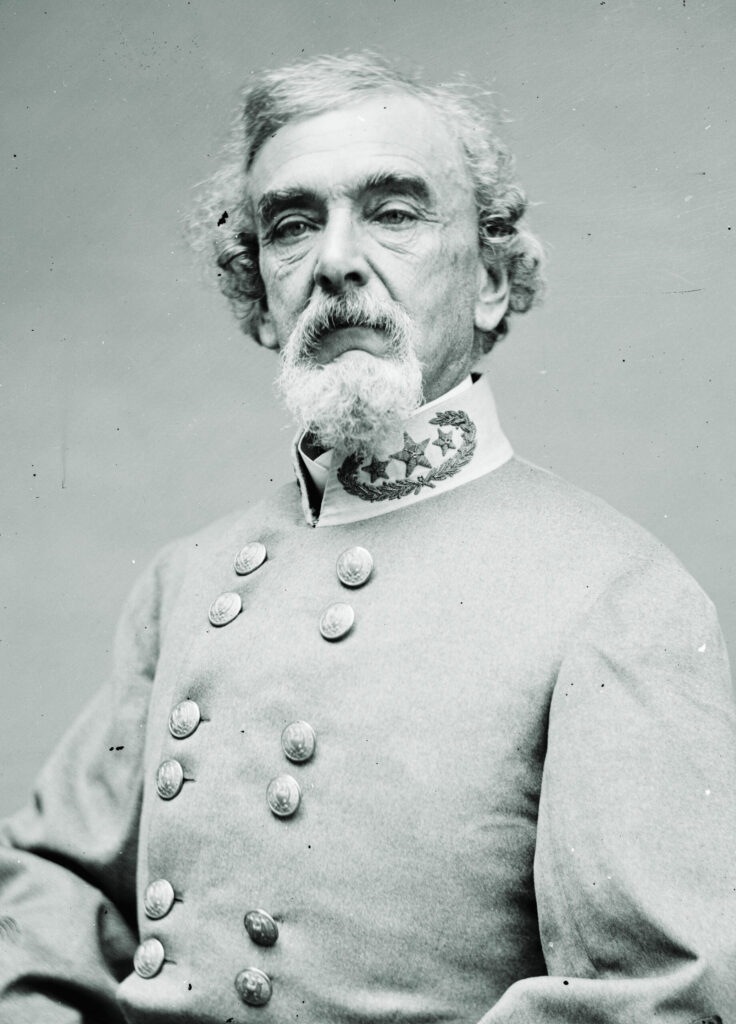
On the battle’s first day, however, Longstreet had used only six of the 13 brigades available to him. Four of those belonged to Hill, with “Pete” sending only two more forward—those of Colonels James Kemper and Micah Jenkins—both at Hill’s request for more support. Of the 13,800 men he had present for duty in his division, nearly 9,500 of them never fired a shot.
Facts do not support Longstreet’s claim his division was “greatly cut up” and its “ammunition nearly exhausted.” Kemper’s and Jenkins’ losses were only 7 percent of the division’s overall casualties. By contrast, Hill engaged his entire 10,250-man division and reported nearly 3,000 casualties (29 percent). In fighting later that afternoon, Whiting (handling Smith’s Division) suffered 1,278 casualties (13.7 percent of the 10,590 men present).
The purpose of Longstreet’s letter to Johnston was twofold. First, it launched the narrative that all blame was to be squarely placed on Huger. Second, it signaled a measure Johnston could use in explaining why complete victory had not been not achieved, which would be particularly useful when offered to a increasingly critical President Davis and the Richmond press.
In his after-action report, prepared three days later, Longstreet asserted, “Agreeably to verbal instructions from the commanding general,” which indicates to an uninformed reader that what followed was in accordance with Johnston’s directive. Any “misunderstanding” of verbal instructions could thus be seen as a useful alibi instead of an admission of willful insubordination.
“The division of Maj. Gen. Huger was intended to make a strong flank movement around the left of the enemy’s position and attack him in the rear of that flank….,” Longstreet noted. “[T]his division did not get into position in time for any such attack.”
His brazen distortion of facts did not end there: “I have reason to believe that the affair would have been a complete success had the troops upon the right been put in position within eight hours of the proper time.” Longstreet followed with: “Some of the brigades of General Huger’s division took part in defending our position on Sunday [June 1], but…did not show the same steadiness and determination of Hill’s division and my own.”
This report, and Longstreet’s letter written June 7, put Johnston in an awkward position, as he was now compelled to support this narrative rather than supply a more accurate and truthful account.
Only three of six brigade commanders in Anderson’s ranks issued after-action reports—Colonel Micah Jenkins, Brig. Gen. George Pickett, and Brig. Gen. Cadmus Wilcox—and no officers in the unit’s 23 regiments did so. Plus, the three brigades with no reports issued were not engaged on May 31, and only minimally engaged on June 1, with no reported casualties.
Jenkins’ report detailed the extensive fighting by his portion of Anderson’s Brigade, but only for May 31, and Anderson did not complete a report. Pickett’s report was minimalist at best, with no insight on his initial marching orders or to any subsequent orders from Longstreet before 9 p.m. May 30.
Only Wilcox mentioned any substantive content of Longstreet’s orders: “On the 30th ultimo[,] orders were received to be prepared with ammunition….for an early march the following morning. At 6:30 a.m. the brigade moved from its camp near the Mechanicsville Pike by by-paths across to the junction of the Charles City and Williamsburg Roads” [italics added by author].
Wilcox’s report clearly indicates no orders involving movement toward Old Tavern on the Nine Mile Road, as would have been Johnston’s expectation. One can presume that each of those in brigade command received similar orders, as the whole division wound up along the Williamsburg Road.
The orders described in Wilcox’s report would have been issued shortly after Longstreet left Johnston’s headquarters at approximately 9 p.m. May 30. In 1896, Longstreet wrote: “There was no reason why the orders for march should be misconstrued or misapplied”—a curious comment considering Longstreet’s June 10, 1862, report, which did not divulge the nature of his orders. It is interesting how Longstreet maintained there was “no reason” for misconstruing his orders, yet his report focuses on Hill and Huger while offering little data regarding his own division’s actions.
A common belief offered on Longstreet’s behalf is the lack of clarity of Johnston’s verbal orders. Johnston, however, clearly intended and expected Longstreet to operate as a commander of three divisions and to engage his division from Old Tavern upon hearing the opening of Hill’s attack. Longstreet failed to do either. Even if one accepts a “misunderstanding,” Longstreet’s battlefield conduct is hard to justify.
In 1877, Longstreet best described his lack of leadership when he wrote to Hill: “I do not remember giving an order on that field other than to send you my brigades as you called for them.” Hill later wrote that “Longstreet was not on the field at all on the 31st of May, and did not see any of the fighting.” And Longstreet’s poor battlefield leadership continued June 1, with Hill recalling he “received no orders from General Longstreet whatever.” Longstreet’s admission and Hill’s verifications certainly do not portray the actions of a wing commander responsible for actively directing and managing the operations of three divisions.
False Statements
By placing his affinity for Longstreet above the truth, Johnston shared equally in crafting the “misunderstanding” and in actively engaging in the character assassination of Huger.
After graduating from West Point in 1825, Benjamin Huger spent the next 35 years primarily as an ordnance officer in the U.S. Army. In 1861, he resigned from Federal service to join the Confederate Army but quickly ran afoul of an investigation conducted by the Confederate House of Representatives for failure to reinforce and supply troops at Roanoke Island, N.C., where he commanded. His reputation sullied, Huger became an easy target for further criticism, whether warranted or not.
Neither Johnston nor Longstreet respected Huger, and Johnston had publicly criticized Huger for abandoning the Norfolk Naval Yards in May 1862 and the subsequent demolition of the ironclad CSS Virginia, even though Huger had simply been following Johnston’s own orders.
Although Huger lacked experience as a field commander, his division was the only one conveniently placed to cover Hill’s flank along the Charles City Road in the attack and, given the overall simplicity of his plan, Johnston had no reason to expect anything but success.
Johnston’s report of June 24, 1862, took full advantage of Longstreet’s narrative and directly conflicted with Smith’s earlier report. Before evaluating Johnston’s report, however, it is important to turn to Smith’s notes and comments about what had transpired on May 31. (Smith entered handwritten comments on his original report while in Macon, Ga., in June 1865.) On the morning of May 31, and throughout much of the day, Smith was with Johnston. They interacted and communicated constantly, and both knew Longstreet had deviated from Johnston’s orders.
The request by Johnston for secrecy perplexed Smith:
“Johnston’s letter indicated a desire to keep back important facts. And he is mistaken in supposing that the misunderstanding between himself and General Longstreet did not affect the operations of my division. And he is mistaken that no one knew of this…
“General Johnston did not know where Longstreet was. But he explained his intentions freely & fully to the effect that the right wing under Longstreet composed of three divisions viz – His own [Anderson’s], D.H. Hill’s and Huger’s were to attack the enemy very early in the morning before eight o’clock. D.H. Hill by the Williamsburg Road…Huger on Hill’s right…and Longstreet’s own division on Hill’s left moving into position on the nine miles road….[All my] staff officers and Generals knew where Longstreet was supposed to be and they knew Genl. Johnston’s intentions and orders in regard to the troops they were to support. I gave them the information and certainly did not dream that there was any occasion for secrecy or ‘reticence’ then, nor do I perceive it now.”
Later in Smith’s 1865 endorsement, he addressed the so-called misinterpretation with: “So much for the misunderstanding between Johnston and Longstreet….My opinion is that it would have been better for both had Johnston stated and explained it.”
What Johnston’s official report had emphasized was that Longstreet’s Division supported Hill’s Division along the Williamsburg Road, and that Longstreet had “the direction of operations on the right.” Huger “was to attack in flank the troops who might engage with Hill and Longstreet,” and “General Smith was to be in position along the Nine Mile Road “to be in readiness either to fall on Keyes’ right flank or cover Longstreet’s left.”
The only factual statement here is that Longstreet possessed command of operations on the right (although he did little commanding). The other statements are all false. “[H]ad General Huger’s division been in position and ready for action…,” Johnston opined, “I am satisfied that Keyes’ Corps would have been destroyed rather than being merely defeated.”
GET HISTORY’S GREATEST TALES—RIGHT IN YOUR INBOX
Subscribe to our HistoryNet Now! newsletter for the best of the past, delivered every Monday and Thursday.
Johnston knew the plan he described in his report is not the one he outlined to Smith and others on May 31. Rather than personally adapting and adjusting to the new situation when the plan unraveled, he became sullen and passive. At 10 a.m., hearing no sounds of musketry or distant cannon fire, Johnston asked a staff officer if there might be a mistake—that his ears had deceived him. When the officer confirmed the silence, the dejected Johnston sighed, “I wish the troops were back in their camps.”
Ironically, it was the success of Jenkins’ Brigade that demonstrated just how successful an attack down the Nine Mile Road could have been. Jenkins’ 1,900-men drove across a portion of the Federal right flank near Fair Oaks Station and then followed a path down and across the Nine Mile Road while cutting behind the Federal lines at Seven Pines.
Jenkins’ attack along a similar path to Longstreet’s, with six brigades, should have been launched from Old Tavern that morning. Given the success Jenkins demonstrated, one can only ponder the success Longstreet’s full division might have attained. An earlier attack down the Nine Mile Road would in all probability have convincingly won the day for Johnston’s army.
Wrote Keyes: “[T]he right was on ground so favorable to the approach of the enemy and so far from the Chickahominy that if Johnston had attacked there an hour or two earlier than he did, I could have made but a feeble defense…and every man of us would have been killed, captured or driven into the swamp or river before assistance could have reached us.
The specifics of Longstreet’s June 7 letter to Johnston remained unknown to Smith, Hill, and others until its publication in the Official Records. Smith and Hill were equally rattled, with Hill penning in a letter to Smith on May 18, 1885: “I cannot understand Longstreet’s motive in coming over to the Williamsburg Road, nor can I understand Johnston’s motive in shielding him.”
Hill and Smith were incensed at Longstreet’s claims that his division had endured “perhaps the hardest part of the battle” and that it had been “greatly cut up….[their] ammunition…nearly exhausted.”
“Longstreet was not on the field at all on the 31st of May and did not see any fighting,” Hill wrote. “He ought to have known that I got no assistance from him except for the brigade of RH Anderson [i.e., Jenkins]….I have not felt kindly to Longstreet since I read that letter of his to Joe Johnston. I can’t understand how he had the brass to write such a letter.”
In his Battle of Seven Pines, published in 1891, Smith expressed his sympathy for Huger, as “the erroneous statements of Generals Johnston and Longstreet, in regard to Huger’s instructions, have been incorporated into history.”
“Too Much Censured”
The only official support Huger received immediately after the battle came in Wilcox’s June 12 report. Wilcox had commanded three of Longstreet’s brigades along the Charles City Road on May 31 and had been in regular contact with Huger. He knew Huger was not at fault for the disruption at Gillies Creek.
An undated addendum in Wilcox’s report, presumably added after Johnston’s report appeared, states: “At Seven Pines, the successful part of it was Hill’s fight. I have thought that General Huger was a little too much censured for Seven Pines by the papers.”
Johnston continued the “blame Huger” theme in a post-war article he wrote for Century Magazine titled “Manassas to Seven Pines,” as did Longstreet in his 1896 account, “From Manassas to Appomattox.”
Huger did not see the critical reports by Longstreet and Johnston about his performance until August 1862 and immediately sought redress from both. Longstreet never responded, and Huger wrote directly to Johnston on September 20 after waiting more than a month for a reply, maintaining: “As you have indorsed his erroneous statements, to my injury, I must hold you responsible.”
Receiving no reply from Johnston either, Huger penned a letter to Davis, along with an extract of Johnston’s Seven Pines report, refuting what the commander had written. Davis referred the remarks to Johnston, receiving a supercilious response. He essentially blamed Huger for not raising the issue sooner and that an investigation was now impossible because Longstreet was unavailable, adding that “the passage in my report that he complains about was written to show that the delay in commencing the attack on May 31 was not by my fault.”
Huger attempted to right the wrong through the Confederate government itself—to no avail. He demanded Davis create a board of inquiry, and though the request was approved, that board never met.
Huger dropped the issue after the war. In 1867, he wrote: “[I]f our cause had been successful, I would have insisted on an investigation; I determined that it was now no time to redress wrongs; that I must continue to bear them and I would not mention a word about Gen. Johnston.” Thus, Huger’s name and character would continue to carry the blame for the failure of the May 31 Confederate attack at Seven Pines.
Mercifully, by late July 1862, Huger no longer held a field command, reassigned to the administrative role of inspector general for artillery and ordnance. Johnston, meanwhile, resumed leading Confederate armies in November.
Perhaps Gustavus Smith provided the best description as to how history should view Longstreet’s lack of ethical credibility when he wrote: “General Longstreet, in command of the three divisions which were to have crushed Keyes corps before it could be reinforced blundered badly from the beginning to the end of the battle; and to say the least, his writings in reference to Seven Pines are no more creditable than his conduct of operations on this field.”
Victor Vignola writes from Middletown, N.Y. This article is adapted from his book Contrasts in Command: The Battle of Fair Oaks, May 31–June 1, 1862 (Savas Beatie, 2023).

